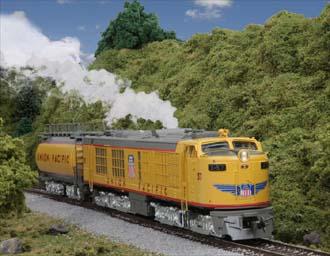
November 3, 2010 - In the late 1940s, even as it was building diesels in partnership with Alco, General Electric was experimenting with ways to apply its aircraft jet engine technology to railroading. Its gas turbine electric was basically a diesel engine with a large turbine replacing the diesel as the prime mover. Click on the video icon to the left to see the engine in action.
In a turbine, intake air is compressed by spinning turbine blades and fed into combustion chambers, where fuel is added and ignited, as in a jet engine. The hot exhaust gases spin the blades of another turbine that powers one or more generators, which produce electricity to power diesel-type traction motors. Compared with diesels of the period, GE's turbine put three times as much power in one locomotive, had significantly fewer moving parts, and did not vibrate like a diesel. The major drawback was a voracious appetite for fuel.
Union Pacific's president Art Stoddard referred to the locomotives as "jet propulsion on wheels", claiming the turbine gas engines "might well revolutionize American railroading". The Baby's 4500hp turbines demonstrated the locomotives ability to go faster then diesel engines and appeared, at the time, to be the more economical choice.
While not intended for passenger use, on occasion the gas turbine 4500 locomotive pulled in a streamlined passenger train after a diesel engine would break down. Although the locomotive was not designed for multiple unit operation, they were occasionally double loaded, even through long tunnel routes where recalculation of exhaust gasses could pose problems.
After two years of testing GE's prototype, the Union Pacific ordered its first ten GTELs in 1951. The engines were designed to burn Bunker C oil, a byproduct of petroleum distillation that was almost considered waste material. The low cost of Bunker C more than compensated for the turbines' high consumption, although the oil was so thick it had to be heated to 240 degrees Fahrenheit to flow though the fuel system.
In 1955 auxiliary fuel tenders were added to the locomotives, this additionally 24,000 gallons of oil allowed the train to make longer runs, increasing monthly mileage.
Averaging around 10,000 miles a month (400 turbine operating hours), the locomotive also contained a 250hp diesel engine, which was used to bring the turbine engine up to its firing speed of 700RPM. This allowed the engine to then run fans, pumps, cooling motors, auxiliaries, and allowed the locomotive to move around terminals when running light.
Unfortunately, by the early 1960s, the turbines' use of Bunker C fuel had changed from an advantage to a problem. The plastics industry had found new uses for the former waste product and its price skyrocketed. At the same time, the corrosive nature of the fuel led many of the turbines to develop engine problems. The Verandas were retired in 1963-64 in favor of newer 8500hp Big Blows, and the UP's entire turbine program was finished by 1970.
Featuring the same detailing fidelity and features of its bigger brother, the Veranda - MTH's first Union Pacific Turbine - the 4500 comes outfitted with variable intensity smoke, operating Mars light, built in DCC decoder plug, die-cast metal construction, twin flywheel-equipped motors, and four traction tires to provide pulling power in a model that rivals the prototype.
WHERE TO BUY
The 4500 can be ordered through any M.T.H. Authorized Retailer.
